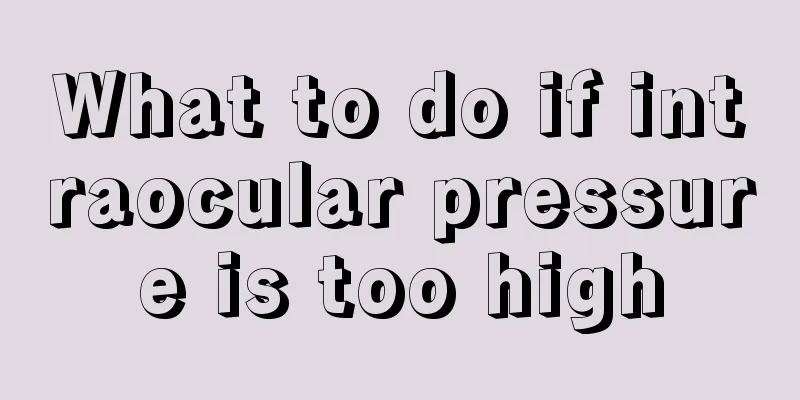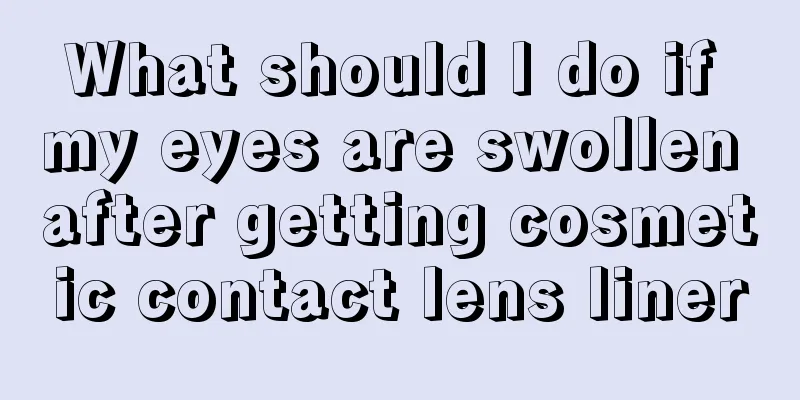What to do if intraocular pressure is too high

|
High intraocular pressure is a common phenomenon among people today. Due to the great pressure of social competition, people's life pressure will also increase accordingly. Staying up late to work overtime is common. Due to long-term mental activities, the eyes cannot get a good rest. Coupled with some habits in life, high intraocular pressure is inevitable. Therefore, it is a wise choice to correctly understand intraocular pressure and find solutions. 1. Lower the insulin level in the body. People who are obese, have diabetes or high blood pressure are often resistant to insulin, causing the body to secrete more insulin. High intraocular pressure is also related to high insulin levels in the body. [2] To address the problem of high insulin, patients often need to avoid foods that cause insulin spikes, including sugar, grains (whole and organic), bread, pasta, rice, cereal, and potatoes. 2. Exercise more. Doing more exercises such as aerobics, jogging, brisk walking, cycling and strength training can lower the insulin level in the body and thus reduce the risk of high intraocular pressure. Insulin is a hormone that helps the body move sugar from the blood into cells to provide energy. If we consume this energy through exercise, the blood sugar level will decrease and the insulin level will also decrease. When the insulin level decreases, the stimulation to the ocular sympathetic nerves is reduced, and there is no high intraocular pressure. Aim to exercise for 30 minutes a day, 3 to 5 times a week. Avoid any movements or postures that require your head to be tilted downward, as these movements can increase eye pressure. Certain yoga poses and inversions fall into this category. 3. Take dietary omega-3 fatty acids. DHA is a type of omega-3 fatty acid that can maintain good visual function and prevent high intraocular pressure. Deep-sea fish such as sardines, tuna, salmon, shellfish and herring are rich in DHA and other omega-3 fatty acids. It is recommended to consume this fish two to three times a week to supplement DHA. Of course, you can also take fish oil capsules or seaweed health products to supplement DHA. The optimal dosage is 3000-4000mg per day of standard fish oil capsules, or 200mg of algae DHA supplement. 4. Eat more foods containing lutein and zeaxanthin. Lutein and zeaxanthin are both carotenoids that have antioxidant properties and can help the body fight free radicals. Free radicals can affect the body's immune system, leading to infection and damage to the optic nerve. Lutein and zeaxanthin can also reduce oxidative damage to the optic nerve and lower intraocular pressure. It is important to know that any damage to the optic nerve will increase intraocular pressure, so it is important to protect the optic nerve. Foods rich in lutein and zeaxanthin include kale, spinach, broccoli and raw egg yolks. Try to eat a little of these foods with your main meals every day. 5. Don’t eat trans fats. Omega-3 fatty acids can reduce intraocular pressure, but foods rich in trans fats can hinder the effect of omega-3 fatty acids and contribute to high intraocular pressure. Therefore, it is best to reduce your intake of foods rich in trans fats. These foods include processed or baked foods, fried foods, ice cream, microwave popcorn and ground beef. 6. Eat more antioxidants. Dark berries such as blueberries, blackberries and raspberries can nourish the capillaries and promote nutrient supply to the nerves and muscles of the eyes, which helps improve overall eye health. Dark berries have this effect because they are rich in antioxidants, which strengthen blood vessels, thereby reducing bleeding and damage. Aim to eat at least one serving of dark berries every day. Alpha lipoic acid (ALA) is an antioxidant used to prevent and treat eye diseases including glaucoma and ocular hypertension. The usual dosage is twice daily. Raspberries are often used to improve visual acuity and combat degenerative eye diseases such as ocular hypertension. One product that contained raspberries and Pycnogenol (a pine bark extract) was investigated and found to have the effect of lowering intraocular pressure in clinical trials. Grape seed extract is also an antioxidant and can effectively reduce ocular hypertension caused by glare. Grape seed extract is commonly used to fight aging and improve night vision. 7. In places where marijuana is legal, some people use marijuana to lower intraocular pressure. Marijuana is available in edibles, sublingual pads, capsules, pills, and aromatherapy oils. Cannabidiol (CBD), a component of marijuana that is non-neurotropic and can lower intraocular pressure. 20-40mg of cannabidiol (CBD) can effectively treat ocular hypertension. |
<<: Tips on how to remove dental plaque
>>: Which blood spot should I press for toothache
Recommend
What are the examination and diagnosis methods for lung cancer? 5 things to know about the examination and diagnosis methods for lung cancer
What are the diagnostic methods for lung cancer? ...
Does October Xin have any side effects?
Shiyuexin is a formula that most people are not a...
Is castor bean effective when applied topically?
Castor beans are a very common plant seed and are...
Inguinal warts
The groin is considered a private place in the ey...
How serious is the harm caused by testicular cancer
How serious is the harm caused by testicular canc...
Why do I always feel the urge to urinate at night?
It is normal to urinate when you feel like urinat...
How to correct tooth gaps after tooth extraction
Nowadays, when many people find that their teeth ...
Can thyroid nodules be cured? What are the treatments?
Thyroid nodules are a common thyroid disease, aff...
What to eat in the late stage of liver cancer? Analysis of dietary precautions in the late stage of liver cancer
The mortality rate of liver cancer is very high, ...
What are the causes of high fasting blood sugar?
Generally, blood sugar measurement needs to be do...
Symptoms of urethral stricture, hazards and treatment of urethral stricture
Urethral stenosis is a common urinary system dise...
Why do I always choke when eating
I believe that many people have experienced choki...
Cost of early treatment of ovarian tumors
The ovaries are important reproductive organs for...
Patients with laryngeal cancer should pay more attention to its common symptoms
In recent years, the incidence of laryngeal cance...
What if you don’t have a bottle opener? Learn these simple ways to open red wine
We often drink red wine in our daily lives, but t...









